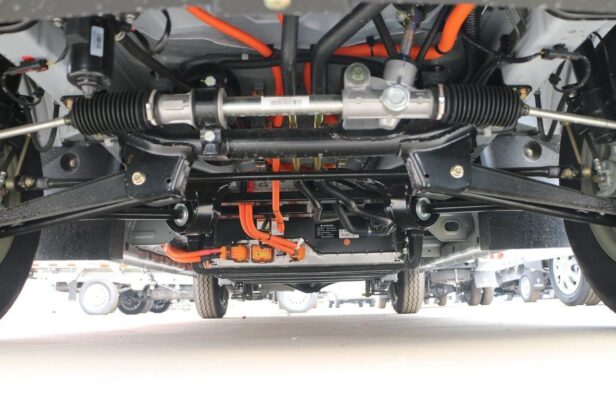دانش کامیون برقی
What to Pay Attention to When Charging Pure Electric Trucks on Rainy Days
ارسال شده در توسط کامیون های برقی
The author is of the opinion that there are indeed specific precautions to be observed when charging کامیون برقی خالصs on rainy days. Now, the author will elaborate on these points for you in detail.

- Choose to Charge in an Open Area During Thunderstorms If Possible
It is important to understand that the charging pile itself is designed to be electrically safe and incorporates a certain level of protection functionality. با این حال, the author still strongly recommends choosing an open area for charging during thunderstorms. This recommendation is based on several key considerations. Firstly, an open area reduces the risk of water accumulation and potential electrical conduction through standing water. Even though the charging pile is engineered to handle moisture and has built-in safeguards, minimizing the exposure to pooled water adds an extra layer of safety.
Let’s expand on this further. During thunderstorms, the risk of lightning strikes exists. In an open area, the chances of a direct lightning hit to the charging setup are relatively lower compared to enclosed or confined spaces. علاوه بر, an open area provides better ventilation, which helps in dissipating any heat generated during the charging process and reduces the potential for moisture-related issues within the charging equipment.

- Keep the Human Body Away from the Charging Pile
When undertaking the charging process of a کامیون برقی خالص in the rain, it is of utmost importance for the human body to maintain a safe distance from the charging pile. Moisture in the environment increases the risk of electrical conduction, and any accidental contact with the charging components could lead to a dangerous electrical shock.
The human body is a conductor of electricity, and in rainy conditions, with increased moisture and potential water droplets on the charging pile surface, the risk of electrical current passing through the body is significantly heightened. Even a slight touch or proximity could result in a life-threatening situation.

- Do Not Wipe the Charging Port or the Charging Gun Head with Rainwater by Hand
On rainy days, it is strictly prohibited to directly touch the charging port with your bare hands. If wiping is necessary due to excessive rainwater accumulation, it is essential to use appropriate tools such as tissues or dry rags. Direct hand contact with the charging port in wet conditions poses a significant risk of electrical shock and can also introduce contaminants or damage to the sensitive charging components.
Let’s explain this in more detail. The charging port is a critical interface where electrical connections are made. Moisture and dirt can interfere with the proper connection and potentially cause short circuits or damage to the charging system. Using clean and dry tissues or rags helps remove the moisture without causing any harm to the equipment or exposing oneself to electrical hazards.

- Do Not Pull Out the Charging Head Directly
Many individuals, driven by convenience or a lack of awareness, may be inclined to directly pull out the charging head. This is an incorrect and potentially dangerous practice. The correct procedure involves first powering off the charging pile and only then removing the charging head.
The sudden and forcible removal of the charging head while the charging process is ongoing can cause electrical arcs, damage to the charging connectors, and pose a risk of electrical shock. By following the proper sequence of powering off the charging pile first, the electrical flow is safely interrupted, allowing for a safe and smooth removal of the charging head.

- Do Not Throw the Charging Head Randomly
After the charging is completed, it is imperative not to haphazardly discard or throw the charging head. Once used, the charging head should be promptly and carefully returned to its designated storage or original position.
Improper handling or random placement of the charging head can lead to physical damage, dirt accumulation, moisture ingress, and potential disconnection of internal wiring. Maintaining a proper storage and handling practice ensures the longevity and reliability of the charging equipment and reduces the risk of faults or safety hazards during subsequent charging operations.
The above are the crucial points to keep in mind when charging کامیون برقی خالصs on rainy days. The author sincerely hopes that the content shared can prove beneficial and informative to everyone, enhancing safety and ensuring efficient charging operations even in less than ideal weather conditions.
در نتیجه, when charging کامیون برقی خالصs in the rain, a heightened sense of caution and strict adherence to these precautions are essential. By being vigilant and following the correct procedures, we can safeguard both the charging equipment and our personal safety, promoting the reliable and safe use of pure electric vehicles in all weather scenarios.